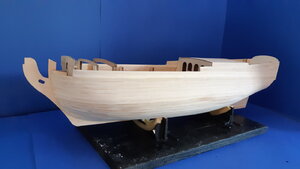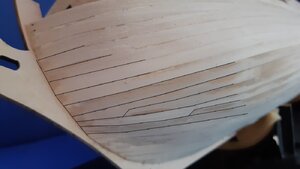The planking scheme on any ship is purely a math problem, namely "how many full width planks strakes will fit into a given vertical hull length". The ship designer had to know how to calculate the length from rabbet to wale and design the ship such that, at the very least, no plank was narrower than 50% (and hopefully none of them were) of the average plank width. Poor designers might end up with straight run planks an inch wide (requiring numerous stealers). Incompetent designers would end up with planks that came to a point at the stem (as illustrated in the color photo) or, ended at the underside of the wales (both cases are an absolute no-no, You would be hard pressed to count the number of photos of this apparently accepted mess that were presented as feature articles in Model Ship Builder). Fair designers would have planking schemes that could be constructed with some spiling. The best designers would build ships with parallel edge planks (they actually knew how to perform longhand addition and division). The two photos above represent an aaverage job with stealers on the left. There is nothing wrong with stealers other than they represented a lot of extra work and money to construct. The color photo on the right represents either what was required to plank a ship designed by an incompetent fool or, the the model design of a ship never built scribbled onto paper by a drunk or, drugged, or very low IQ employee at a model manufacturing company; there are no acceptable excuses for this kind of incompetence. No amount of skilled workmanship can turn this mess into anything even remotely considered as representing reality. I won't apologize for the negatives simply because I see this kind of "crap" being sold at exorbitant prices to people who apparently don't know what a ship really looked like. Shame on the people who put together these abortion kits and a word of advice to builders to do some research on their own.







